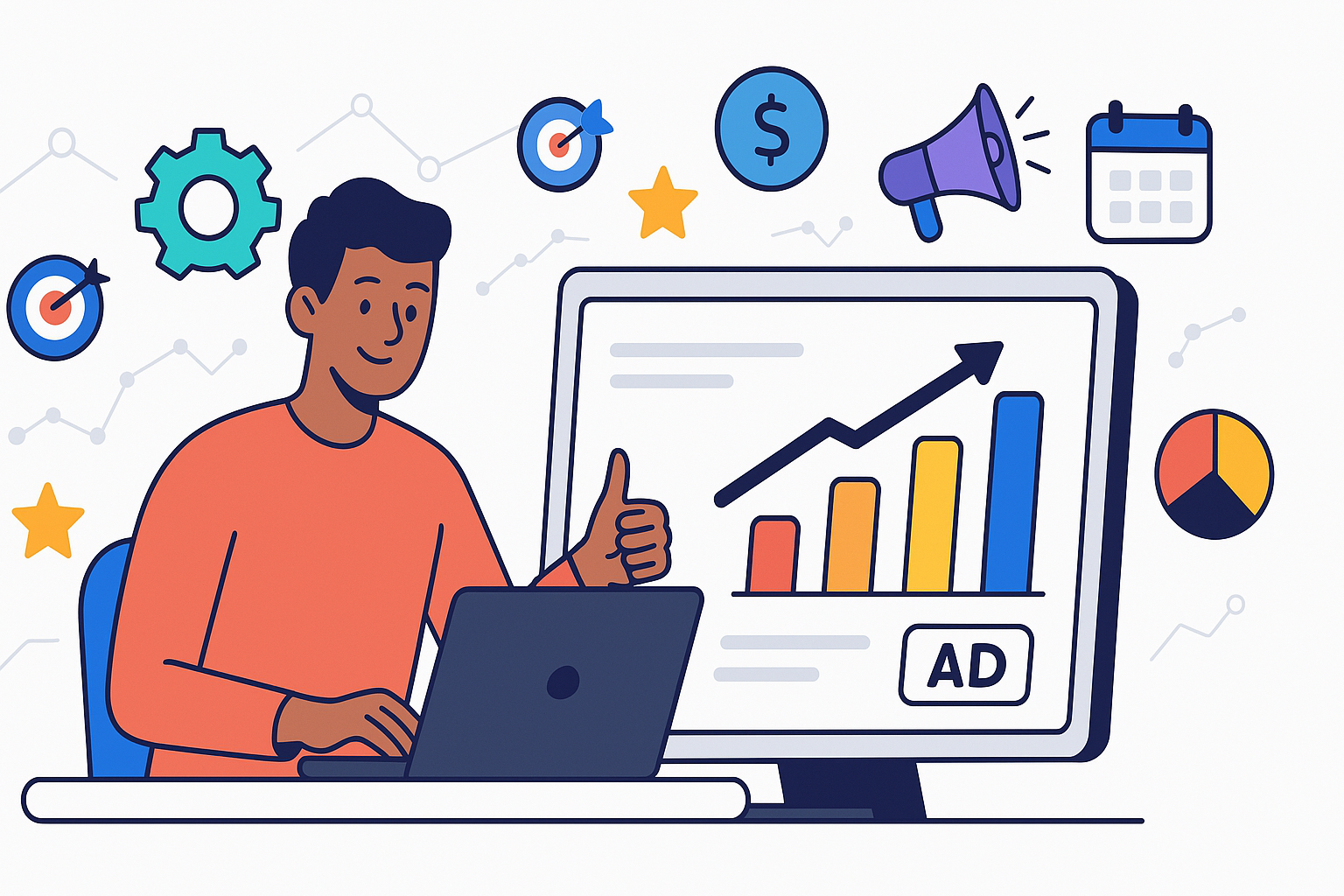Decoding Snapchat Ads Cost: Your Budgeting Guide
by Francisco Kraefft on 10 Dec, 2024
Snapchat isn't just for fleeting moments and fun filters; it's a powerful advertising platform connecting businesses with millions of engaged users, particularly younger demographics. But before diving in, a crucial question arises: what is the actual Snapchat ads cost? Understanding the financial aspect is key to unlocking this platform's potential without breaking the bank. While there's no single fixed price, the cost is dynamic, influenced by various factors you control. This guide breaks down the complexities of Snapchat advertising costs, equipping you with the knowledge to budget effectively, optimize your spending, and drive meaningful results for your business. Let's explore how you can make Snapchat ads work for your budget.
How Snapchat's Ad Auction Determines Your Initial Cost
At its core, Snapchat advertising operates on an auction system, similar to many other digital advertising platforms. Think of it as a dynamic marketplace where you bid against other advertisers vying for the same audience's attention. You aren't just paying a flat fee; you're competing for ad placements.
Here’s the basic mechanism:
-
You Define Your Goal: First, you choose a campaign objective (e.g., drive website traffic, increase app installs, generate leads, boost awareness).
-
You Set Your Bid: You tell Snapchat how much you're willing to pay for a specific action (like a swipe-up, an install, or a thousand impressions), or you can let Snapchat automate the bidding process based on your goals (Auto-bid).
-
Snapchat Considers Multiple Factors: When deciding whose ad to show, Snapchat's algorithm doesn't just look at the highest bid. It considers:
- Your Bid Amount: How much you're willing to pay.
- Predicted Action Rates (pAR): How likely Snapchat thinks a user is to take the desired action (e.g., swipe up, install) after seeing your ad. This is based on historical data, your ad creative's quality, and audience relevance.
- Ad Quality & Relevance: How engaging and pertinent your ad is to the target audience.
-
The Winner is Chosen: Snapchat combines these elements to determine an overall value score for each competing ad. The ad with the highest score wins the auction and gets displayed to the user.
What Does This Mean for Your Cost?
- It's Variable: Your cost per result (like cost per swipe-up or cost per install) isn't fixed. It fluctuates based on the competition and the factors mentioned above.
- You Often Pay Less Than Your Max Bid: In many auction types (specifically second-price auctions, though Snapchat's exact model evolves), you typically pay just slightly more than the next highest bidder needed to win, not necessarily your maximum bid amount. This encourages truthful bidding.
- Optimization is Key: Simply bidding high isn't always the best strategy. A highly relevant, engaging ad might win auctions even with a slightly lower bid than a less relevant competitor.
Understanding this auction dynamic is the first step. It highlights that you have significant influence over your Snapchat ads cost through strategic planning, targeting, and creative execution, not just by setting a bid.
Unpacking the Key Factors That Influence Snapchat Ad Pricing
While the auction sets the stage, several specific Key Factors directly impact how much you'll ultimately spend on your Snapchat campaigns. Mastering these variables allows you to exert greater control over your Snapchat ads cost and improve your return on investment.
-
1. Your Campaign Objective: What do you want users to do? The goal you select significantly influences cost. Objectives tied to higher-value actions generally cost more.
- Awareness Campaigns (e.g., Impressions): Often cheaper per action, as the goal is broad visibility (measured by Cost Per Mille, or CPM).
- Consideration Campaigns (e.g., Swipe-Ups, Website Visits): Moderate cost, focused on engagement (measured by Cost Per Swipe-Up, CPSU, or Cost Per Click, CPC - related to Click-Through Rate).
- Conversion Campaigns (e.g., App Installs, Purchases, Leads): Typically the most expensive per action, as they target users most likely to perform a valuable conversion (measured by Cost Per Install, CPI, Cost Per Action, CPA, or Cost Per Purchase). Learn about conversions here.
-
2. Audience Targeting: The more specific and in-demand your target audience, the higher the potential cost due to increased competition.
- Demographics (Age, Location, Language): Broader targeting might be cheaper but less effective.
- Interests & Behaviors: Targeting users based on their known interests (e.g., gamers, fashion enthusiasts) can increase competition.
- Custom Audiences (Lookalikes, Engagement Audiences): Targeting users similar to your existing customers or those who've interacted with your brand can be highly effective but potentially more costly due to higher value.
-
3. Ad Format: Different Snapchat ad formats come with varying levels of engagement potential and creative requirements, influencing cost.
- Single Image/Video Ads: Standard, versatile, often a cost-effective starting point.
- Story Ads: More immersive, appear in the Discover section, potentially higher engagement and cost.
- Collection Ads: Showcase multiple products, ideal for e-commerce, often tied to conversion goals, potentially higher CPA.
- AR Lenses & Filters: Highly engaging and shareable, often used for branding/awareness. Lenses usually involve higher creative development costs and potentially higher campaign costs due to their immersive nature.
-
4. Bidding Strategy: How you choose to bid in the auction directly impacts spend.
- Auto-bid: Snapchat manages bids to get the most results for your budget (good for beginners).
- Max Bid: You set the maximum you'll pay per action (more control, requires monitoring).
- Target Cost: You specify an average cost per action you'd like to achieve (balances cost control and volume).
-
5. Seasonality and Competition: Demand fluctuates. Expect costs to rise during peak seasons (like holidays) or major events when more advertisers compete for attention.
-
6. Ad Quality and Relevance Score: Snapchat rewards engaging, relevant ads. High-quality creatives that resonate with the audience often achieve better auction performance and potentially lower costs per result, as Snapchat predicts they will perform well.
By carefully considering and adjusting these factors, you move from simply paying for ads to strategically investing in targeted reach and measurable outcomes.
Exploring Snapchat Ad Formats and Their Cost Considerations
Snapchat offers a diverse range of ad formats, each designed for different objectives and user experiences. The format you choose directly impacts creative possibilities, user engagement, and, consequently, your overall Snapchat ads cost. Let's break down the main types:
-
Single Image or Video Ads (Snap Ads):
- Description: Full-screen vertical ads appearing between Stories or in the Discover section. Can include attachments like website links, app install prompts, or longer video views.
- Best For: Driving traffic, app installs, video views, general awareness.
- Cost Considerations: Generally the most standard and often cost-effective format. Costs vary based on objective (CPM for awareness, CPSU/CPC for traffic, CPI for installs). Highly dependent on creative quality and targeting.
- Pro Tip: Ensure your creative is instantly engaging within the first 1-2 seconds.
-
Story Ads:
- Description: A branded tile in the Discover section that opens into a collection of 3-20 Snap Ads. Users choose to engage.
- Best For: Deeper storytelling, product launches, content promotion.
- Cost Considerations: Can be more expensive than single Snap Ads due to placement and format potential, but often drives higher engagement from interested users. Bidding is typically based on impressions (CPM) for the tile placement.
- Pro Tip: Create a compelling narrative arc across your Snaps within the Story Ad.
-
Collection Ads:
- Description: Showcase a series of products within a single Snap Ad. Users can tap on products to learn more or purchase.
- Best For: E-commerce, direct product promotion, driving online sales.
- Cost Considerations: Often tied to conversion goals (purchases, add-to-carts), so CPA might be higher, but the potential for direct ROI is significant. Requires a product catalog setup.
- Pro Tip: Use high-quality product images and clear pricing/calls to action.
-
AR Lenses:
- Description: Interactive augmented reality experiences users can apply to their Snaps. Can be targeted by audience (Audience Lenses) or location (Sponsored Lenses for broad reach).
- Best For: Brand engagement, viral potential, unique interactive experiences, awareness.
- Cost Considerations: Development costs for custom Lenses can be substantial. Campaign costs vary widely based on reach and targeting. Audience Lenses operate within the auction, while Sponsored Lenses often involve higher, fixed costs for massive reach.
- Pro Tip: Focus on fun, shareable experiences that align with your brand.
-
Filters:
- Description: Static or dynamic graphic overlays users can add to their Snaps, often location-based (Geofilters) or tied to events.
- Best For: Location-specific promotions, event marketing, brand awareness.
- Cost Considerations: On-Demand Geofilters can be relatively inexpensive for small areas and short durations. Broader or longer campaigns cost more. Costs are influenced by location size, duration, and demand.
- Pro Tip: Design visually appealing filters that complement user Snaps naturally.
Choosing the right format involves balancing your campaign goals, creative capabilities, and budget. While some formats like AR Lenses might seem expensive upfront, their unique engagement potential can offer significant value depending on your objectives.
Setting Realistic Budgets and Smart Bidding Strategies
Understanding the factors and formats is crucial, but translating that knowledge into a practical budget and effective bidding strategy is where successful campaigns are forged. Let's talk about managing your Snapchat ads cost proactively.
Setting Your Budget:
Snapchat offers flexibility in how you allocate your funds:
- Daily Budget:
- Description: You specify the maximum amount you want to spend per day. This provides tight control over daily expenditure, preventing overspending. It's useful for testing or maintaining a consistent presence.
- Consideration: Your campaign might not spend the full daily budget if opportunities within your bid/target cost aren't available.
- Lifetime Budget:
- Description: You set a total budget for the entire duration of the campaign. Snapchat's algorithm will aim to spend this budget efficiently over the scheduled flight dates, potentially spending more on high-opportunity days and less on others.
- Consideration: Provides more flexibility for Snapchat's pacing optimization but requires confidence in the total budget allocation.
Which should you choose?
- Start with Daily Budgets: If you're new to Snapchat ads or testing new strategies, daily budgets offer more control and allow for quicker adjustments.
- Consider Lifetime Budgets for Optimized Pacing: Once you have a better understanding of performance, lifetime budgets can allow Snapchat to optimize spend more effectively across the campaign's duration.
Minimum Spends: Snapchat generally requires a minimum daily budget (often around $5), but effective campaigns usually require a more significant investment to gather enough data for optimization.
Choosing Your Bidding Strategy:
This tells Snapchat how to compete in the ad auction based on your goals:
- Auto-bid:
- How it works: Snapchat automatically bids to get the most goal actions (e.g., swipe-ups, installs) possible within your budget.
- Pros: Simple to set up, leverages Snapchat's algorithm.
- Cons: Less direct control over the cost per action (CPA).
- Best for: Beginners, maximizing volume, campaigns where CPA goals are flexible.
- Max Bid:
- How it works: You set the maximum amount you are willing to pay for a single goal action.
- Pros: Direct control over the maximum cost per result.
- Cons: Might limit reach if your bid is too low to win auctions; requires careful monitoring and adjustment.
- Best for: Advertisers with specific CPA targets, experienced users.
- Target Cost:
- How it works: You specify an average cost per action you aim to achieve. Snapchat adjusts bids to meet this target over time.
- Pros: Balances cost control with volume, aims for stable average costs.
- Cons: Actual cost per action can fluctuate above or below the target in the short term.
- Best for: Advertisers focused on achieving a consistent average CPA while maximizing conversions.
Starting Point Recommendation: For many advertisers, starting with Auto-bid and a Daily Budget allows you to gather initial performance data. Once you understand baseline costs (like your average CPSU or CPI), you can transition to Target Cost or Max Bid strategies for more refined control over your Snapchat ads cost.
Measuring ROI and Optimizing Your Snapchat Ad Spend
Launching a Snapchat campaign is just the beginning. To truly make your budget work hard, continuous monitoring, analysis, and optimization are essential. This is where a data-driven approach transforms spending into strategic investment, maximizing your Return on Investment (ROI).
Key Metrics to Track:
Your chosen campaign objective dictates the primary metrics, but keep an eye on these fundamentals:
- Spend: How much of your budget has been used.
- Impressions: How many times your ad was displayed.
- Reach: How many unique users saw your ad. (Learn about Reach & Frequency)
- eCPM (Effective Cost Per Mille/Thousand Impressions): Cost per 1000 impressions – key for awareness. (What is CPM?)
- Swipe Ups / Clicks: Number of users who engaged directly (depends on attachment). (Understanding CTR)
- CPSU (Cost Per Swipe Up) / CPC (Cost Per Click): Cost for each engagement – key for traffic/consideration. (Understanding CTR & Costs)
- Installs / CPI (Cost Per Install): Crucial for app promotion campaigns.
- Conversions (Leads, Purchases, etc.) / CPA (Cost Per Action): The ultimate measure for conversion-focused campaigns. (What are Conversions? / Calculate CPA)
- ROAS (Return on Ad Spend): Revenue generated divided by ad spend – the gold standard for e-commerce and sales-driven campaigns. (Calculate ROAS)
- Frequency: Average number of times a unique user saw your ad. (Learn about Reach & Frequency)
Leveraging Snapchat's Reporting:
Snapchat Ads Manager provides robust reporting tools. Regularly analyze performance by:
- Campaign, Ad Set, and Ad Level: Identify what's working and what's not at each level.
- Demographics: See how different age groups, genders, or locations respond.
- Placement: Understand performance differences between Stories, User Stories, Publisher Stories, etc.
- Device: Analyze performance across iOS and Android.
Optimization Strategies:
Based on the data, take action:
- A/B Testing: This is non-negotiable for optimization. (What is A/B Testing?) Test variations of:
- Creatives: Different visuals, videos, calls-to-action, opening hooks.
- Audiences: Test different interest groups, lookalikes, or demographic segments.
- Bids & Budgets: Experiment with different bid strategies or budget allocations.
- Ad Formats: Compare performance between Snap Ads, Story Ads, etc.
- Calls to Action: Test different wording or attachment types.
- Refine Targeting: If certain audience segments are underperforming or too expensive, pause them or adjust your targeting. Double down on high-performing segments.
- Adjust Bids: If using Max Bid or Target Cost, adjust based on performance. If CPA is too high, cautiously lower bids. If you're not spending your budget and missing opportunities, consider increasing bids slightly.
- Optimize Creatives: Pause low-performing ads. Allocate more budget to winning creatives. Refresh creatives regularly to combat ad fatigue.
- Review Campaign Goals: Ensure your campaign objective still aligns with your business goals and observed performance.
The iVirtual Approach: At iVirtual, we live and breathe data. As a performance marketing agency, we continuously monitor campaign metrics against established KPIs, conduct rigorous A/B tests, and dynamically adjust strategies. This iterative process ensures that every dollar spent on Snapchat ads is optimized for maximum impact, driving scalable results for our clients. Effective Snapchat advertising isn't about setting and forgetting; it's about constant learning and refinement to lower costs and boost ROI.
Conclusion
Navigating Snapchat ads cost requires understanding the interplay between the auction, your campaign choices, and ongoing optimization. While costs vary based on your goals, audience, creative, and bidding strategy, it's not an unpredictable expense. By strategically managing these factors – from selecting the right objective and ad format to setting appropriate budgets and diligently measuring results – you can run highly effective Snapchat campaigns. Remember, the focus shouldn't solely be on minimizing cost, but maximizing value and achieving tangible business outcomes. With careful planning and data-driven adjustments, Snapchat can be a cost-effective channel for growth.
Ready to optimize your Snapchat ads cost and achieve measurable results? Let our data-driven experts craft and manage your campaigns for maximum ROI. Contact us today!


